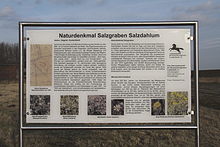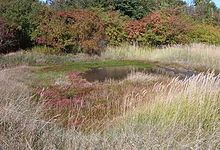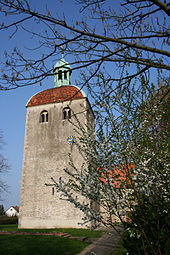Salt dahlum
|
Salt dahlum
District town Wolfenbüttel
|
|
|---|---|
| Coordinates: 52 ° 11 ′ 47 " N , 10 ° 35 ′ 10" E | |
| Height : | 92.62 m above sea level NN |
| Area : | 13.38 km² |
| Residents : | 1606 (December 31, 2017) |
| Population density : | 120 inhabitants / km² |
| Incorporation : | March 1, 1974 |
| Postal code : | 38302 |
| Area code : | 05331 |
|
Location of Salzdahlum in Wolfenbüttel
|
|
Salzdahlum is a village in the Wolfenbüttel district in Lower Saxony . Today it is part of the district town of Wolfenbüttel .
history
Salzdahlum was first mentioned in 888 as Dalhem . Other names were Daleheim (1112), Saltdahlheim (1204) and in the 17th century Salzthalen . The name probably means "home in a valley". The word salt was added later, with the salt spring near the place giving it its name. The early establishment of the town can be traced back to fertile arable land and the presence of water. Originally there were Ober- and Niederdahlum, two neighboring villages on the Hain- and Wohlbleeke. They later carried the common name Salzdahlum, although still separately. As part of the separation , on May 1, 1857, they were united with the ducal domain to form the municipality of Salzdahlum. In the 18th century, Oberdahlum had a font court yard, Niederdahlum the princely summer palace Salzdahlum , its garden and the administrative building. The church stood in the middle between the two villages.
In the place name book from 1894 the sugar factory (located near the salt spring) is mentioned, in which the Wolfenbütteler Landtag is said to have met.
The main attraction of the place was its salt spring, which is already reported in 888. On the eastern Salzberg already existed in 1300, a Saline , it has ceased operations. 1853 South of the “Salzbergstrasse” from Salzdahlum to Sickte, there is a small hill on the honeycomb , where salt water still emerges today and determines the vegetation that otherwise only occurs on the coast of the sea.
On March 1, 1974, Salzdahlum was incorporated into the district town.
politics
Local council
Since the local election on September 11, 2016, the local council has been composed as follows (changes compared to 2011):
Local mayor
Local mayor is Ralf Achilles (SPD).
coat of arms
In the 1999 coat of arms there are three silver salt crystals, which, in their arrangement, indicate the meaning of the place name "Salz-Talheim". Their number corresponds to the old town centers of Oberdahlum, Niederdahlum and Salzdahlum. The ducal hat (crown) stands on the green ground (salt marshes, baroque gardens, agriculture). Like numerous other coats of arms in the region around Braunschweig and Wolfenbüttel , the coat of arms was designed by the heraldist Arnold Rabbow.
Culture and sights
Salt mountain
On the Salzdahlum-Sickte road there is a sign indicating the Salzgraben Natural Monument , where an asphalt dirt road turns. 50 meters behind, on the left-hand side, is the place that has been designated as a Salzgraben Salzdahlum natural monument since 1980 .
In the Lower Saxony region, the origin of many salt springs goes back to the Zechstein Sea , which separated from the ocean 200 million years ago and formed a shallow basin over the whole of northern Germany. Under the influence of a desert-like climate, evaporation set in, with lime , gypsum , halite (rock salt) and potash salts precipitating in succession . Originally, the salt layers were horizontal. This changed 150 million years ago when the deposits in the Saxon orogeny were pressed into huge sticks. The deposited salt was plasticized by the pressure and transported upwards in faults, weak points and cracks. In the Wolfenbüttler area, the extraction of evaporated salt on the salt ditch near Salzdahlum and on the salt meadow near Barnstorf can be traced back to the Middle Ages , but it may have started much earlier. As early as 1864, new life was stirring on the Salzberg: Salzdahlum farmers had recognized the benefits of growing sugar beet . They founded the Actien sugar factory and built factory buildings, some of them on the saltworks site.
Salzdahlum summer palace
The Salzdahlum pleasure palace owes its existence to Duke Anton Ulrich's dream of a palace that should overtake Versailles . In 1677 the castle project was tackled southwest of the village, where the manor garden, meadows and fields extend today. The magnificent castle was inaugurated in 1694.
From 1689 the garden artist Martin Charbonnier worked on the design of the pleasure garden.
In 1713 Tsar Peter the Great visited the Wolfenbüttler Herzogshof and thus Salzdahlum. Crown Prince Friedrich of Prussia married Elisabeth Christine von Braunschweig-Wolfenbüttel-Bevern here in 1733 .
However, due to its light wooden construction, the castle did not last long: the damp subsoil caused the buildings to fall into disrepair and maintenance was costly. In 1811 King Jerome of Westphalia donated the palace buildings to the city of Braunschweig and expected them to be restored in a representative way. The city had the castle torn down in 1813.
At the site of the palace complex there is now farmland with no visible remains. There are still some outbuildings, such as the Alte Wache, once the gatehouse to the castle, and the riding school that has been converted into a storage shed . Numerous accessories of the castle (capitals, columns, furniture, pictures, sculptures) can still be found in parks, courtyards, apartments and museums in the area. There is a baroque gate entrance at the monastery courtyard in Mönchevahlberg , the cavalier's house was rebuilt on the estate of those of Münchhausen in Groß Vahlberg . Hans Pleschinski gives a humorous description of the palace and its builder in his story Der Holzvulkan , published in 1986 .
Virgin monastery "To the glory of God"
The wife of Anton Ulrichs, the Duchess Elisabeth Juliane founded the virgin monastery “To the honor of God” at Salzdahlum Castle in 1701. Due to the poor condition of the buildings, the idea arose in 1789 to move the monastery to Wolfenbüttel, but the Princely Chamber rejected this request. After Domina von Schliestedt described her stay in the building as "life-threatening" and confirmed her wish to move with the transfer of 2000 gold thalers from her own treasury, a house in Wolfenbüttel was acquired from the Dedekind family and in 1791 the monastery was moved there. The last provost Heise in Salzdahlum died in the same year. Since then, the first preacher at the main church in Wolfenbüttel has held the post of provost.
Church of St. Jürgen
The church was built between the two originally independent districts of Ober- and Niederdahlum. Accordingly, it originally had two entrances. The one on the north side was used by the Oberdahlumers, the one on the south side by the Niederdahlumers. Little is known about the history of the Church. Their architectural style is considered a transition style between Romanesque and Gothic. It is assumed that it was built around 1200. Your name "St. Jürgen "is the Low German version of" St. Georg ". The origin of the name is obscure. The name is documented in a copy book of the Braunschweig Aegidienkloster , to which the parish was obliged to pay taxes.
Personalities
- Franz Anton Knittel (1721–1792), general superintendent in Wolfenbüttel and Braunschweig and palaeographer
- Johann Gottlieb Friedrich Schrader (1763–1833) German physicist and chemist.
literature
- Hans Wiswe: History of the salt works at Salzdahlum. A contribution to the history of industry and technology . In: Braunschweiger Jahrbuch . 3. Episode 4, 1943, p. 75-112 .
- Gerhard Gerkens: The princely pleasure palace Salzdahlum and its builder, Duke Anton Ulrich von Braunschweig-Wolfenbüttel . Braunschweig 1974.
- Hans Pleschinski: The wood volcano. Report of a biography . ISBN 978-3-9802446-1-9 (humorous description of castle construction and builder).
Web links
- Salzdahlum on the Wolfenbüttel website
- Private website about salt dahlum
- Description of the salt ditch near Braunschweigische Landschaft
Individual evidence
- ^ Population of the localities and districts of Wolfenbüttel
- ^ Federal Statistical Office (ed.): Historical municipality directory for the Federal Republic of Germany. Name, border and key number changes in municipalities, counties and administrative districts from May 27, 1970 to December 31, 1982 . W. Kohlhammer GmbH, Stuttgart and Mainz 1983, ISBN 3-17-003263-1 , p. 273 .
- ^ Website of the communal data processing in Oldenburg , accessed on October 2, 2016
- ↑ Helmut Knocke : Charbonnier. In: Dirk Böttcher , Klaus Mlynek, Waldemar R. Röhrbein, Hugo Thielen : Hannoversches Biographisches Lexikon . From the beginning to the present. Schlütersche, Hannover 2002, ISBN 3-87706-706-9 , p. 84, online via Google books
- ↑ Johannes Beste: History of the Braunschweigische Landeskirche from the Reformation to our days. Wolfenbüttel 1889.








